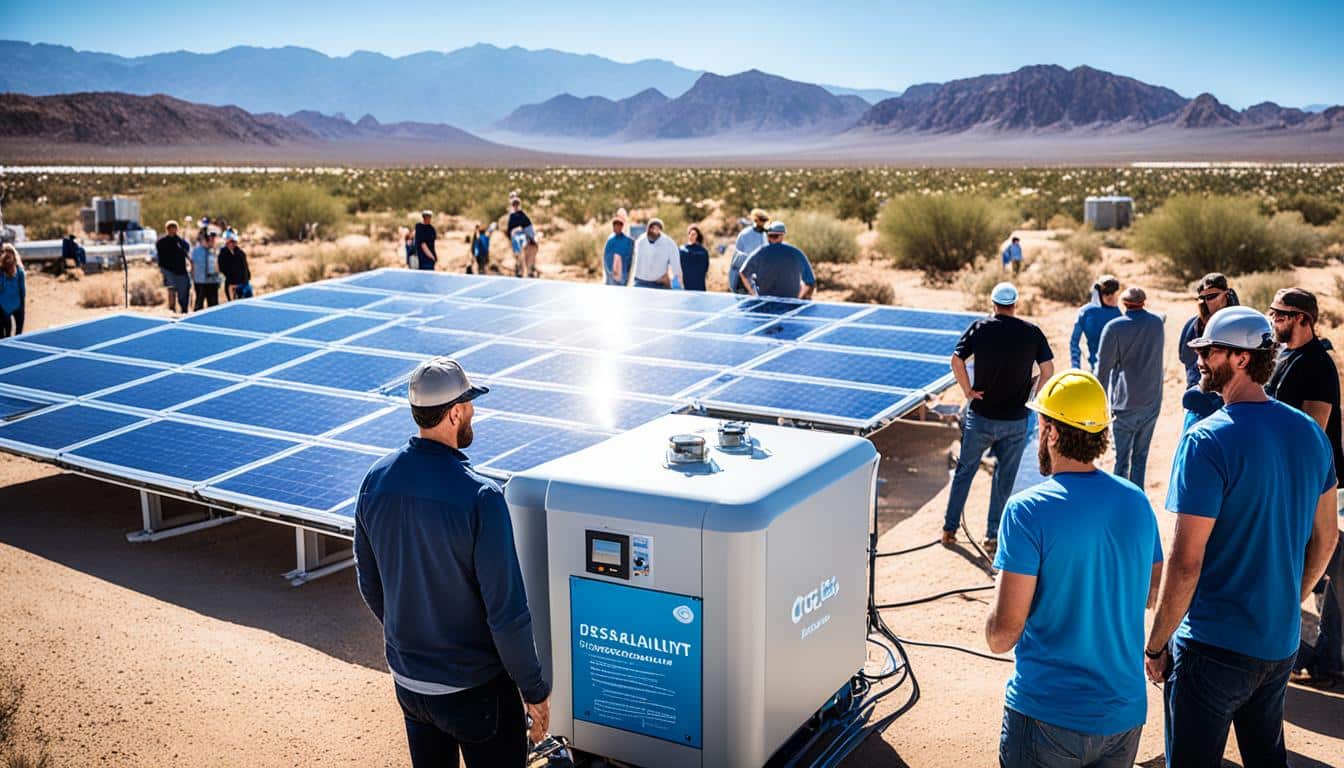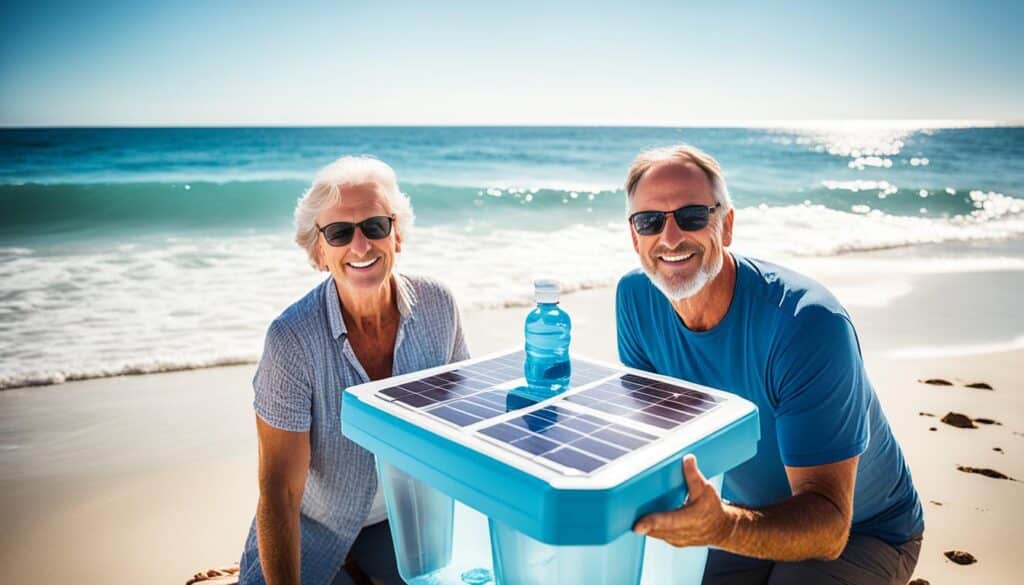
Solar energy is changing how we get fresh water through desalination. This topic looks at how solar power and desalination work together. It talks about new methods, the issues we face, and the hope it brings for our dry world.
Using solar energy for desalination is key for keeping our planet safe and making sure we have enough water. This is especially true in dry or far-off places where regular power is hard to find. With solar desalination, areas can use less fossil fuel, protect the environment, and have a steady water supply.
Key Takeaways:
- Solar energy is making it easier to get fresh water through desalination.
- Desalination powered by the sun lowers our need for gas and helps the planet.
- It gives a steady water source, which is crucial in dry, distant spots.
- New methods like using carbon nanomaterials and mixing systems boost how well solar desalination works.
- It’s important to keep researching and improving solar-powered desalination for more places to benefit.
The Role of Solar Energy in Water Scarcity and Desalination
Water scarcity is a big issue around the world. It’s getting worse because of climate change, more people, and growing industries. Some places without much water have started turning to sea water desalination. This process needs a lot of energy, often from fossil fuels. This harms the environment.
Solar power is changing this. It’s clean and can make water desalination plants work without harming the planet. Using solar technology like solar stills makes the process more affordable and Earth-friendly.
“Solar energy offers an eco-friendly and sustainable solution by powering water desalination plants.”
Solar power does more than save the Earth. It also makes sure there’s enough water, especially in dry and faraway lands with lots of sunlight. There, solar energy helps make water and saves the environment.

Advantages of Solar Energy in Desalination:
- Eco-friendly: Solar energy helps cut down on pollution and harm to natural life by providing a clean, renewable source of power.
- Energy Sustainability: Solar power can make desalination plants more self-sufficient, using less fossil fuel, and make water production more reliable.
- Cost-effectiveness: Using the sun for desalination cuts the need for costly fuel, making water more affordable for everyone.
- Technology Accessibility: Solar energy is becoming easier to use. It helps places that are far away from main power sources get clean, fresh water.
Challenges and Future Outlook:
Solar power for making water is still facing challenges. We need better and cheaper ways to desalinate water with the sun. Storage for water is also a big need, plus systems that can work for more people.
The good news is, we’re making progress. With better solar technology, new materials, and creative designs, solar desalination is looking up. It might change dry areas into places that flourish, with a stable supply of fresh water.
| Water Scarcity | Desalination | Solar Energy | |
|---|---|---|---|
| Definition | The inadequate supply of safe and clean water to meet the demands of a region or population. | The process of removing salt and impurities from seawater or brackish water to produce freshwater. | The conversion of sunlight into usable energy, often used to power various applications. |
| Global Impact | Increasing water scarcity due to climate change, population growth, and industrialization. | Essential for addressing water shortages and providing a reliable source of freshwater. | Reduces reliance on fossil fuels, mitigates environmental impact, and enhances sustainability. |
| Environmental Concerns | Adverse effects on ecosystems, biodiversity, and natural resources. | Energy-intensive process often reliant on fossil fuels, contributing to carbon emissions. | Eco-friendly, reduces greenhouse gas emissions, and minimizes environmental impact. |
| Future Outlook | Implementing sustainable water management strategies and technologies for long-term water security. | Advancing solar desalination technologies to enhance efficiency, cost-effectiveness, and scalability. | Continued research and development to improve solar technology and increase accessibility. |
Innovations in Solar Desalination Technologies
Solar energy and water desalination are now working together, leading to many new ideas. These new ways help make using the sun to turn saltwater into fresh water better. They also make it cheaper and better for our planet.
Carbon Nanomaterials: Enhancing Efficiency and Selectivity
Carbon nanomaterials like graphene have changed how we look at solar desalination. They have special features that help make the water purifying process more efficient. This means they can pull out more salt and other bad stuff from the water.
By adding carbon nanomaterials to the filters, researchers have made big strides. They can get rid of more salt and dirt, leading to more water and water that’s better for us.
This new approach could make making fresh water from the sun and seawater cheaper and more doable. This is very important for places that have a hard time getting fresh water from other sources.
Hybrid Systems: Maximizing Energy Savings
Combining different ways to make fresh water from the sea has also been very successful. These hybrid systems save more energy which is great for the environment and our wallets.
Hybrid systems mix different methods like multi-effect distillation and reverse osmosis. This helps them save more energy and do less harm to the planet.
These systems can use heat and filters together, making them use less energy. This is a big win for making the process of getting fresh water more eco-friendly.
Concentrated Solar Power and PV Technologies: Renewable Heat and Power
Large mirrors and special solar panels have changed the game in how we make fresh water from the sea. They offer new and better ways to use the sun’s energy. This is turning into a big help for many places that lack fresh water.
Better solar panels can now work all by themselves and they don’t need to be near a big power grid. This means we can make fresh water in places far from cities and towns. Solar power and heat can also be saved up to work even when the sun isn’t shining as strongly.
CSP does this by storing the heat it collects, providing a steady energy source even when the sun is hiding.
| Solar Desalination Technology | Applications | Advantages |
|---|---|---|
| Photovoltaic (PV) Solar Panels | Small-scale, off-grid desalination | – A renewable way to get energy – Works in far-off places – Doesn’t need a lot of fixing |
| Concentrated Solar Power (CSP) | Large-scale desalination plants | – Makes steady energy – Works well even without strong sunlight – Can keep heat for later |
These solar technologies joined with desalination are the future of making fresh water. They are clean and good for everyone.

Conclusion
Solar desalination is a game-changer. It can provide clean water across the globe. By using the sun’s power, we cut back on fossil fuels and protect the environment. This method fights water shortages and makes water safer for everyone.
Scientists are making big leaps in solar desalination. They’re using carbon nanomaterials, mix-and-match systems, and new solar technologies. These advances boost how well we can turn seawater into clean, drinkable water. They also find smart ways to fuel the machines needed to do this.
This tech still has room to grow. Someday, it could be a go-to solution for water problems around the world. By supporting solar desalination, we help make sure there’s enough clean water for everyone. This is not just good for fighting water shortages. It’s also great for cutting down on pollution and creating a healthier planet.






